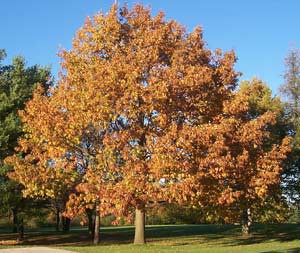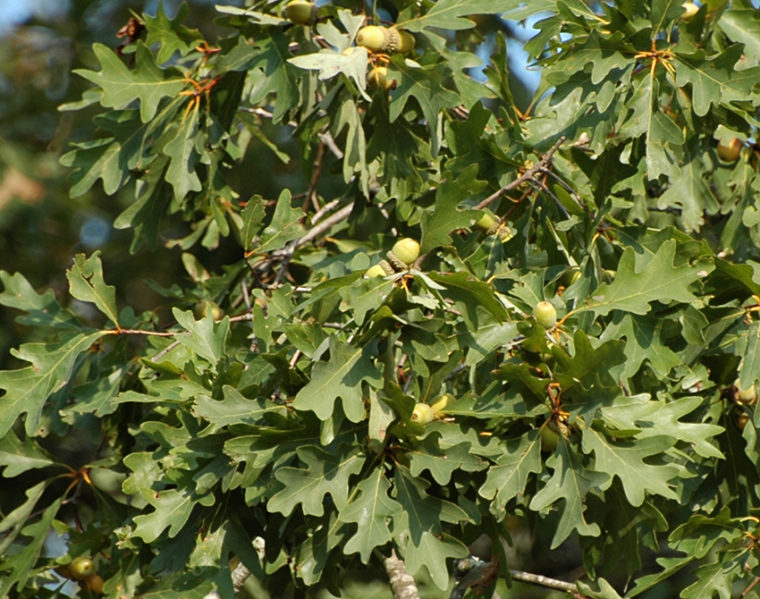To fertilize oak trees, apply a slow-release nitrogen fertilizer during the spring or early summer. Oak trees can greatly benefit from proper fertilization, which can enhance their growth and overall health.
Fertilizing oak trees can be done effectively by using a slow-release nitrogen fertilizer during the spring or early summer. This timing allows the tree to access the nutrients when it needs them most – during its active growth period. However, it’s important to be cautious not to over-fertilize, as excessive nitrogen levels can lead to imbalances and potential damage.

Credit: hawkslandscape.com
By following the appropriate fertilization practices, oak trees can thrive and provide aesthetic value and ecological benefits to their surroundings.
Why Oak Trees Need Fertilization
Oak trees require proper fertilization to maintain healthy growth and vigor. Providing the right nutrients is crucial for their overall well-being. Fertilization supplies oak trees with essential elements that may be lacking in their natural environment. These nutrients help support their growth, improve resistance to diseases and pests, and enhance their overall health and longevity.
Understanding the nutrient requirements of oak trees is important. They particularly benefit from fertilizers that are rich in nitrogen, phosphorus, and potassium. Nitrogen aids in promoting leaf and shoot growth, phosphorus supports root development and flower production, while potassium strengthens the tree’s overall immune system. Applying a balanced fertilizer that contains these nutrients at the appropriate time during the tree’s growth cycle can greatly benefit its health.
It is also important to consider the soil conditions and pH level when fertilizing oak trees. Conducting a soil test can provide valuable information about any nutrient deficiencies or imbalances. Based on the test results, you can adjust the fertilizer application accordingly to ensure that the tree receives the correct nutrients in the right proportions.
In conclusion, fertilizing oak trees is vital for their overall health and growth. It helps provide the necessary nutrients that may be lacking in the natural environment, enhancing their resistance to diseases and pests. By understanding their specific nutrient requirements and soil conditions, you can effectively fertilize oak trees and ensure their long-term vitality.
How to Fertilize Oak Trees : Step by Step Guide
Identifying The Right Time To Fertilize Oak Trees
Oak trees are a beautiful addition to any landscape, and proper fertilization is essential for their healthy growth. Identifying the right time to fertilize oak trees is crucial to ensure optimal nutrient uptake and support their overall health.
One of the factors to consider when determining the appropriate time for fertilization is seasonal variations in nutrient uptake by oak trees. Understanding the specific nutrient requirements during different seasons can help you plan the timing for fertilization.
Monitoring the tree’s growth and health is another important aspect to consider. By observing the tree’s development and assessing its overall health, you can determine the optimal timing for fertilization.
Remember to always follow recommended fertilization practices and guidelines to avoid over-fertilization, which could harm the tree. By fertilizing oak trees at the right time, you can promote their vitality and longevity in your landscape.
Selecting The Right Fertilizer For Oak Trees
When fertilizing oak trees, it is important to select the right fertilizer for optimal growth and health. There are different types of fertilizers available, each with their own nutrient composition and ratios. Understanding these compositions and ratios is crucial in choosing the appropriate fertilizer for your oak trees.
Soil conditions and tree requirements play a significant role in selecting the right fertilizer. Assessing the pH level, nutrient deficiencies, and overall soil health will help determine the nutrient needs of the trees. Oak trees have specific requirements, and it is essential to choose a fertilizer that caters to those needs.
By ensuring that oak trees receive the right amount and balance of nutrients, they can thrive and maintain their health and vitality. It is advisable to consult with a professional arborist or horticulturist for expert guidance on selecting the most suitable fertilizer for your oak trees.
Organic Fertilizers For Oak Trees
The use of organic fertilizers for oak trees offers several benefits. Firstly, organic fertilizers are environmentally friendly as they are made from natural sources such as compost, manure, and bone meal. This means that they do not contain harmful chemicals or synthetic components, ensuring the health and longevity of oak trees. Organic fertilizers also enrich the soil with essential nutrients, promoting strong root development and overall tree growth.
When it comes to selecting organic fertilizers suitable for oak trees, options like fish emulsion, seaweed extract, and cottonseed meal are highly recommended. These fertilizers provide a balanced mix of nutrients including nitrogen, phosphorus, and potassium, essential for the oak tree’s optimal growth and productivity. It is important to follow the recommended dosages and application methods for each type of organic fertilizer to ensure the best results.
List of organic fertilizers suitable for oak trees:
| Type of Organic Fertilizer | Benefits |
|---|---|
| Fish Emulsion | High in nitrogen for leaf development |
| Seaweed Extract | Rich in micronutrients and promotes root growth |
| Cottonseed Meal | Slow-release nitrogen and organic matter for soil health |
Applying organic fertilizers to oak trees can be done using techniques such as top-dressing, which involves spreading the fertilizer on the soil surface around the tree and gently raking it into the top layer. For larger trees, deep root fertilization techniques can be employed to ensure adequate nutrient absorption. It is recommended to consult with a professional arborist for proper application methods and dosages specific to your oak trees.
Inorganic Fertilizers For Oak Trees
Using inorganic fertilizers is a common practice when it comes to nurturing oak trees. These fertilizers offer both advantages and disadvantages that should be considered. On one hand, inorganic fertilizers usually contain a higher concentration of nutrients, ensuring a quick and strong response from the trees. They also provide a more accurate control over the nutrient supply.
However, there are downsides to using inorganic fertilizers as well. They can be harmful to the environment if not applied properly, leading to water pollution or damage to nearby plants and wildlife. Some popular inorganic fertilizers for oak trees include ammonium sulfate, urea, and potassium nitrate, each offering specific compositions that benefit the growth of oak trees. When applying inorganic fertilizers, it is important to follow guidelines to minimize any negative impacts. These guidelines include avoiding excessive application rates, proper distribution, and timing the application according to the tree’s needs.
Techniques For Fertilizing Oak Trees
Fertilizing oak trees is an important step in maintaining their health and promoting their growth. There are several techniques that can be utilized for applying fertilizer to oak trees. One method is the top dressing method, where fertilizer is spread evenly around the base of the tree and watered in. This helps to provide essential nutrients directly to the soil and roots. Another technique is the broadcast method, where fertilizer is evenly scattered over the area surrounding the oak tree.
This method is effective in providing nutrients to a larger area and encourages overall tree health. Additionally, proper deep root fertilization techniques can be employed for oak trees. This involves injecting the fertilizer directly into the ground, allowing it to reach the roots effectively. This method is especially useful for providing essential nutrients to trees in nutrient-deficient soil. Implementing these best practices for fertilizing oak trees will help ensure their vitality and longevity.
Dos And Don’Ts Of Fertilizing Oak Trees
When fertilizing oak trees, it is important to be aware of the dos and don’ts to ensure their health and vitality. Avoiding common mistakes can prevent potential risks and negative consequences that may arise from improper fertilization practices.
Here are some tips to follow for effective and safe fertilization:
- Choose the right fertilizer: Select a slow-release fertilizer specifically formulated for oak trees to provide long-lasting and balanced nutrition.
- Timing is crucial: Apply fertilizer during the early spring or late fall to coincide with the tree’s natural growth cycles.
- Measure accurately: Follow the recommended dosage instructions provided on the fertilizer packaging to avoid over or under-fertilization.
- Avoid fertilizing newly planted trees: Wait until the oak trees are well-established before applying any fertilizer.
- Maintain proper watering: Ensure the trees receive sufficient water after fertilization to aid nutrient absorption and prevent root damage.
- Regular soil testing: Conduct periodic soil tests to assess nutrient deficiencies and adjust fertilization accordingly.
| Common Mistakes to Avoid |
|---|
| Over-fertilization: Excessive use of fertilizers can lead to nutrient imbalances, root burn, and ultimately harm the oak tree. |
| Incorrect timing: Fertilizing at the wrong time of year can disrupt the tree’s natural growth cycles and hinder its overall health. |
| Using the wrong type of fertilizer: Using a fertilizer with high nitrogen content may promote excessive foliage growth but can compromise the tree’s root development. |
By following these guidelines and avoiding common mistakes, you can ensure your oak trees receive the proper nourishment they need for optimal growth and longevity.
Monitoring And Assessing The Impact Of Fertilization
| Signs of Nutrient Deficiency or Excess in Oak Trees |
|
Regular monitoring of oak tree health and growth is crucial after fertilization. This helps identify any signs of nutrient deficiency or excess. Look out for symptoms such as yellowing or discoloration of leaves, stunted growth, or wilting. These could indicate a lack or imbalance of essential nutrients. It is important to adjust fertilization practices based on the tree’s response and soil conditions. Conduct soil tests to determine nutrient levels and pH balance. This information will guide you in selecting the appropriate fertilizer and application rates. By closely monitoring and assessing the impact of fertilization, you can ensure optimal tree health and growth. Keep a record of your observations and make necessary adjustments to your fertilization routine. |
Frequently Asked Questions For How To Fertilize Oak Trees
What Is The Best Fertilizer For Oak Trees?
The best fertilizer for oak trees is a slow-release formula that promotes strong growth.
When Should You Fertilize Oak Trees?
Fertilize oak trees during early spring or fall, avoiding extreme hot or cold temperatures.
Should An Oak Tree Be Fertilized?
Fertilizing an oak tree is beneficial as it promotes healthy growth and provides essential nutrients.
How Do I Keep My Oak Tree Healthy?
To keep your oak tree healthy, follow these 4 guidelines: 1. Regularly water your oak tree to ensure proper hydration. 2. Provide sufficient sunlight by trimming surrounding branches or structures. 3. Apply fertilizer specifically designed for oak trees during the growing season.
4. Regularly inspect for pests or diseases and promptly address any issues.
Conclusion
Properly fertilizing oak trees is essential for their overall health and longevity. By understanding the specific needs of these majestic trees, you can ensure that they receive the necessary nutrients to thrive. Start by choosing a suitable fertilizer, taking into consideration the soil composition and pH levels.
Apply the fertilizer evenly around the base of the tree, avoiding contact with the trunk. It is important to follow the recommended dosage and timing, typically in early spring or fall. Regularly monitor the tree’s growth and adjust your fertilizing approach accordingly.
Remember to water the tree adequately, especially after fertilization, as this helps in nutrient absorption. By implementing these guidelines, you can contribute to the flourishing beauty of oak trees in your surroundings. Happy fertilizing! (150 words)

